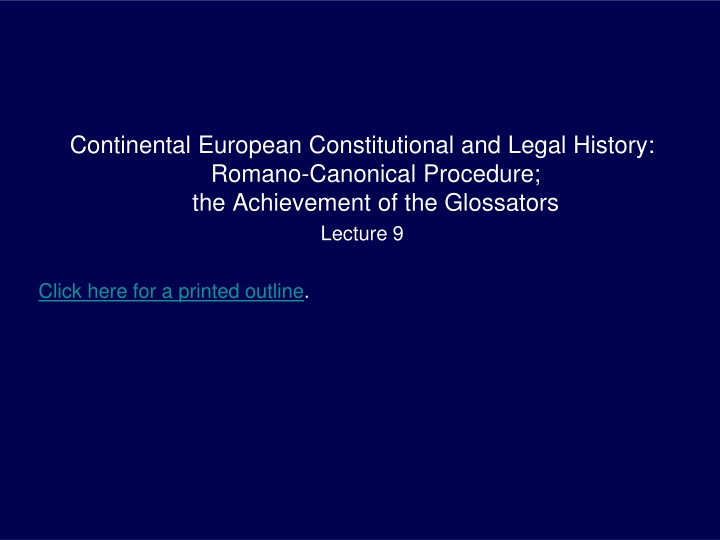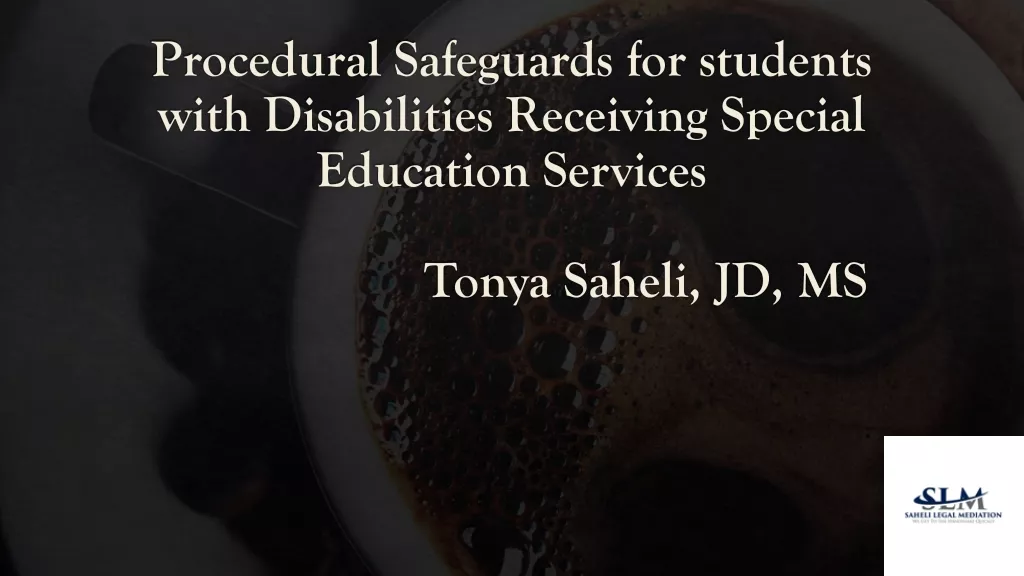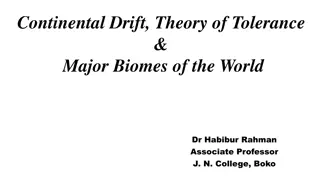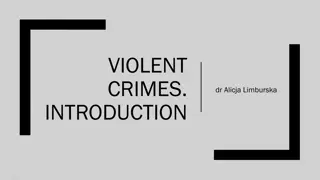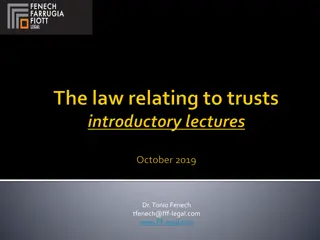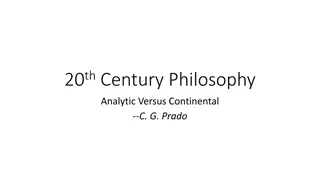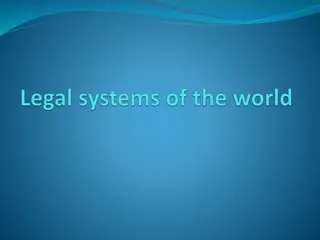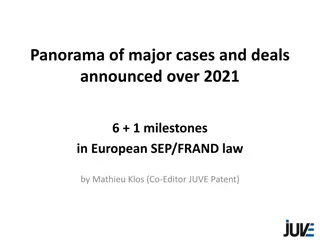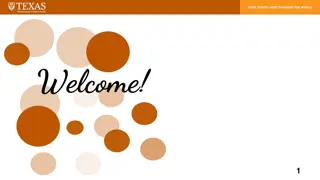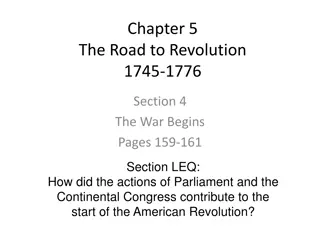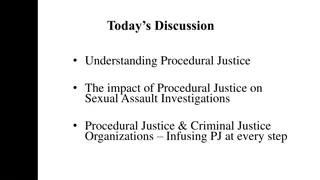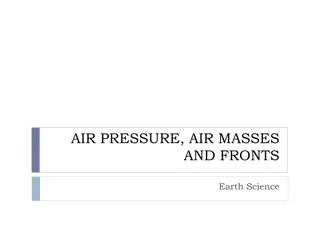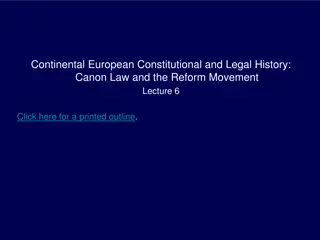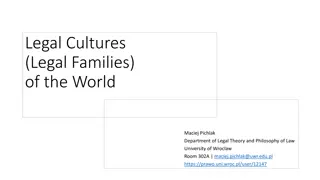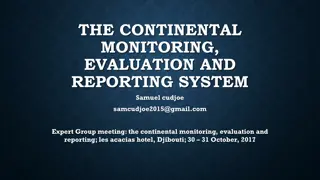Evolution of Procedural Law in Continental European Legal History
The journey of procedural law in Continental European legal history, from the challenges faced by glossators in creating Romano-canonical procedure to the discussions on canonic procedure in canon law. Explore the intricacies of legal procedure development and the influences of historical texts such as the Ordines iudiciarii.
Uploaded on Sep 06, 2024 | 1 Views
Download Presentation

Please find below an Image/Link to download the presentation.
The content on the website is provided AS IS for your information and personal use only. It may not be sold, licensed, or shared on other websites without obtaining consent from the author.If you encounter any issues during the download, it is possible that the publisher has removed the file from their server.
You are allowed to download the files provided on this website for personal or commercial use, subject to the condition that they are used lawfully. All files are the property of their respective owners.
The content on the website is provided AS IS for your information and personal use only. It may not be sold, licensed, or shared on other websites without obtaining consent from the author.
E N D
Presentation Transcript
Continental European Constitutional and Legal History: Romano-Canonical Procedure; the Achievement of the Glossators Lecture 9 Click here for a printed outline.
Introduction Oliver Wendell Holmes, Jr.: [F]or legal purposes a right is only the hypostasis of a prophecy the imagination of a substance supporting the fact that the public force will be brought to bear upon those who do things said to contravene it. If a right is only a prediction of what will happen if it is violated, then we need to know the system by which violations of rights are redressed. How do you get into court? What can you say when you get there? How are facts proven? What remedy will you get? How do I get the government to enforce the remedy that has been granted? What is it going to cost? Only when you know the answers to these questions are you going to able to begin to assess what the likely effect was of given law.
Procedural law before the glossators When the glossators set out to create Romano-canonical procedure, the material that they had from the past was singularly unhelpful. In the case of Roman law the problem was that the texts in the Digest are dependent on a type of procedure that was no longer in use in Justinian s time; so the compilers tended to leave out procedural material in the Digest. There is more procedural material in the Code and the Novels, enough to show the basic outlines of the procedural system of Justinian s time, known as the extraordinaria cognitio, but no one ever tells us the basics, and there is much that is still unknown about it
Procedural law before the glossators (contd) In the case of canon law it seems reasonably clear that no one had ever tried to create a specifically canonic procedure. As in the case of formation of marriage, the church had taken procedure as it found it and had engrafted on it some basic ideas that were of concern. There some examples of this in 74T. A particularly dramatic example is the false decretal that says: A prelate shall not be condemned except with seventy-two witnesses (c.69, tit. 7, p. VI 20; cf. c.84, p. VI 23.) Overall, if a clergyman, particularly a bishop, was to be tried there ought to be legitimate accusers and legitimate witnesses. People ought to have notice and an opportunity to be heard, etc. Many of the basics of what we call due process can be found in this tendentious work. At the same time, there is no evidence that the system of procedure described in 74T was ever implemented; pieces of it may have been quoted in argument, but no one that we know of ever used it as a whole. Indeed, it is hard to imagine how they could have; 74T is hardly a how-to-do-it book.
Ordines iudiciarii Bulgarus de Bulgarinis (1123 X 1141) (written at the request of Aimericus, Chancellor of the Roman Church. Tancredus Bononiensis (1st ed. c. 1216, 2d ed. p. 1234, translated into both French and German). Gulielmus Duranti (Durantis) (1st ed. 1271 X 1276, 2d ed. 1289 X 1291). Some 40 treatises on the whole of the ordo exist from the time before Durantis, many of them still unedited. .
Tancreds ordo: overall outline Part 1, Persons. Part 2, From summons to litis contestatio (joinder of issue), including the exceptions that can be raised before we get to the proof stage Part 3, Proof. Part 4, Sentences, or, as we would say, judgments. .
Tancred on witnesses The form Tancred gives for the admission, examination and reprover of witnesses is part of the standard overall form for the course of judgment in Romano-canonic civil procedure. The case is introduced by a summons and a libel on behalf of the plaintiff and then a joinder of issue (litis contestatio). The plaintiff is then assigned a number of terms (three was standard; a fourth was given as an exceptional matter) to produce witnesses to discharge his burden of proof on his case in chief. Once produced, the witnesses were to take an oath to tell the whole truth and to tell the truth for both parties. They are also to swear that they do not come to bear testimony for a price or out of friendship, or for private hate, or for any benefit they might receive. After they have taken the oath, the witnesses are to be examined separately and in secret, after the model of Daniel s questioning of the elders (Mats., p. II 19).
Tancred on witnesses (contd) When all the witnesses have been examined, the parties are to renounce further production of witnesses. The judge will then order the publication witnesses depositions, which have been written them down, normally by a notary. The defendant now has an opportunity to except to the testimony of the witnesses. He may except to their persons, if he has reserved the right to do so when they are produced, or he may seek to demonstrate that their testimony is false in some respect. The proceduralists not only outlined the form by which witnesses were to be admitted, examined, and reproved; they also elaborated some basic principles of their system of proof by witnesses. At the core of that system are three propositions: The character of each witness is to be examined; certain witnesses are not to be heard because of their status, and others testimony is to be regarded as suspicious because of their status or mores or their relationship to one or the other of the parties. Witnesses are to be examined carefully to determine if they are telling the truth about events they saw and heard themselves.
Tancred on witnesses (contd) On the basis of the written depositions and what has been demonstrated about the character of the witnesses, the judge is to determine whether the standard of proof fixed by law has been met. As a general matter, Tancred tells us, two witnesses make a full proof, but not everyone may be a witness. The section that follows (Mats., part XD) elaborates on the first basic principle noted above. The following may not be witnesses: slaves women (in certain circumstances) those below the age of fourteen the insane the infamous paupers (although Tancred has some doubts about this) criminals no one may be a witness in his own cause
Tancred on witnesses (contd) judges, advocates, and executors in cases in which they have performed their official duties children on behalf of their parents or parents on behalf of their children, with certain exceptions familiars and domestics of the producing party those who are enemies of the party against whom they are produced This is all summed up in perfectly ghastly mnemonic poem on p. IX 7 Condition, gender, age and discretion, Fame and fortune and truth, If these are lacking, Without the court s backing, From witnessing hold em aloof.
Tancred on witnesses (contd) Witnesses are to be questioned, Tancred continues, about all the details of what they have seen a heard, for only then can it be determined whether they are consistent. They are to be asked about the matter, the people, the place, the time, perhaps even what the weather was like, what the people were wearing, who was consul, etc. In only a few instances, such as computing the remoter degrees of kinship in incest cases, is hearsay testimony to be accepted. If a witness contradicts himself, Tancred concludes, then his testimony should be rejected. If the witnesses agree, and their dicta seem to conform to the nature of the case, then their dicta are to be followed. If the witnesses on one side disagree among themselves, then the judge must believe those statements which best fit the nature of the matter at hand and which are least suspicious. If the witnesses on one side conflict with those on the other, then the judge ought to attempt to reconcile their statements if he can. If he cannot, then he ought to follow those most trustworthy the freeborn rather than the freedman, the older rather than the younger, the man of more honorable estate rather than the inferior, the noble rather than the ignoble, the man rather than the woman. (cont d on next slide)
Tancred on witnesses (contd) Further, the truth-teller is to be believed rather than the liar, the man of pure life rather than the man who lives in vice, the rich man rather than the poor, anyone rather than he who is a great friend of the person for whom he testifies or an enemy of him against whom he testifies. If the witnesses are all of the same dignity, then the judge should stand with the side that has the greatest number of witnesses. If they are of the same number and dignity, then absolve the defendant. The basic principle, then, is onus probandi incumbit ei qui dicit( the burden of proof falls upon the person who asserts ).
From 74T to Tancred When the Bolognese glossators began writing, the standard methods for proof in the secular courts were ordeal, battle and compurgation, and compurgation was used in the church courts, and, occasionally, ordeal as well. Witnesses were used in various forms, but appeals to the divine through the ordeal was quite common. The Summula de testibus of an Anglo-Norman canonist of the late 12th century (outline, second listed) repeats an injunction found in Gratian s C.2 q.1 c.2: a bishop is not to be judged unless he himself confesses or unless he is regularly convicted by innocent witnesses canonically examined. This means, the author tells us, not in single combat nor in the trial of hot iron, nor of cold or hot water, nor of lashes, but of oath alone. At the 4th Lateran Council in 1215, the church withdrew its support for the ordeal. The development of an alternative system of proof was the work of the Romano-canonic proceduralists up to and including Tancred.
From 74T to Tancred What happened to the ordeal? [Do this only if time.] In England it disappeared shortly after 1215, replaced by the trial jury in criminal cases, though trial by battle remained a possibility in some criminal cases and in certain types of civil cases. The ordeal also disappeared in France, though it took somewhat longer to happen. Louis IX of France, who died in 1270, promulgated an ordinance of uncertain date, in which he seems to have attempted to abolish trial by battle in the royal courts. By this time the ordeal was probably not being used generally in France. A recent attempt to argue that the ordeal was very long in dying out is flawed, at least in my view, by the fact that it attempts to count the number of ordeals recorded in the thirteenth and early fourteenth century. The statistics are skewed by the fact that that we have records from a large number of cases from Hungary in the early fourteenth century. Hungary in this period was pretty far out of the main stream.
From 74T to Tancred The doctrinal development prior to Tancred, however, is considerable. Gratian s original text had little or nothing on the topic; his students added a long list of excluded witnesses from Roman law. It was far too long and full of anachronisms and bizarities (herewith of publicans, decurions and hermaphrodites). The first treatise on witnesses, written by Albericus de Porta Ravennate sometime in the 1170 s, is also derived solely from Roman law, has a much shorter but also anachronistic list of possible exceptions against the persons of witnesses, mentions the two- witness rule but does not go into the question of how the witnesses are to be examined, and contains no advice on how to resolve conflicts among the witnesses. In the development of practical advice on questioning and on balancing discordant testimony, papal decretal law played a considerable role, as the numerous citations to the Compilationes antiquae in Tancred indicate. Perhaps of equal importance, however, was the work of the proceduralists in the generation preceding Tancred. The first extended discussion of how to question a witness is found in Anon. c.1200. By far the most elaborate treatment of how to evaluate conflicting testimony is found in Pillius (1181 X 1195).
From 74T to Tancred In marked contrast to what we find in the Roman texts and in some of the earlier canonists, the mainstream Bolognese focused on limiting the discretion of the judge. The best explanation for this is probably that they were seeking to separate the role of confessor from that of judge (iudex secundum allegata et non secumdum conscientiam suam debet adiudicari, the judge should judge according to the things alleged and not according to his conscience ). An alternative explanation, not inconsistent with this one, is that in seeking to substitute human judgment for appeals to the divine they needed to convince people that the judge would judge somewhat mechanically, according to rules, and not according his social position and connections.
By Tancreds time did they realize that they had gone too far? If we look at the topic sentences of the paragraphs, it looks as if a great many people can t testify, and that there s not much that the judge can do about it: Slaves are prohibited. Women are prohibited in criminal cases and for testaments. Also prohibited is one younger than fourteen years, generally, in every case. Prohibited is one who lacks discretion or is captive in mind . . . . Prohibited are the infamous, and they are excluded from testimony. Paupers are prohibited from testimony, both by the law of the forum and by the law of heaven. Laymen are prohibited from giving testimony against clerics. [Only in the 2d edition of Tancred.] Infidels are prohibited to give testimony against the faithful. All criminals are prohibited from testimony . . .
Had they gone too far? (contd) Anyone is prohibited from giving testimony in his own case Judges, advocates and executors are prohibited from giving testimony in a case which they have handled. Children are also prohibited from giving testimony for their parents and vice versa. Family members and domestics are prohibited . . . Suspects and enemies are prohibited from giving testimony against their enemy. Each of these propositions is supported by multiple citations to authority. Canonical material, largely derived from Pseudo-Isidore, which appears in the first recension of Gratian. Roman law, which is quite skimpy on this topic, but Gratian s followers had added some Roman sources to the basic texts that Gratian had and the civilians had dug up more from the Corpus Iuris Civilis
Had they gone too far? (contd) Decretal letters of popes who are Tancred s contemporaries or who came in the generation just before him The way to read Tancred s text is to do what he invites you to do: put the material in the citations together into an argument. Putting a cap on witnesses who can excluded. Everyone can be a witness who is not prohibited, because the edict about witnesses, like that about proctors, is prohibitory; all, therefore, who are not prohibited can be admitted. D.22.5.1.1. D.22.5.1.1 (p. I 33): ARCADIUS CHARISIUS, Witnesses, sole book: Oral evidence is often and necessarily given and should be sought particularly from those who are reliable. 1. Witnesses can be called not only in criminal cases but, when appropriate, in money suits, if not forbidden to testify nor excused from testimony by any statute.
Had they gone too far? (contd) Tancred here makes an argument by negative inference. He creates a presumption in favor of admitting the witness. If you want to exclude someone you have to find a specific authority that says that this witness ought to be excluded. This puts a cap on any future development of exclusionary rules. It s a quite typical glossatorial move where they thought that the past had gone too far. In virtually all cases, except perhaps for infidels, the insane and the feeble- minded, Tancred cuts back on what could have been a complete exclusion.
Had they gone too far? (contd): limiting exclusion of women Women are prohibited in criminal cases and for testaments. C.33 q.5 c.17; 1 Comp. 5.36.10; D.28.1.20.6. In other cases, however, pecuniary, spiritual, matrimonial, or any other, women can give testimony, as is contained in [D.28.1.20.6; D.22.5.18] and in [C.15 q.3 c.2; 1 Comp. 2.13.4; 1 Comp. 4.17.1; 3 Comp. 2.12.6]. Tancred starts with Gratian who has in the context of marriage a text that he attributes to Ambrose a very strong statement on the subjection of women leading to their incapacity to testify at all (C.33 q.5 c.17 [p. IX 9]): It is fitting that a woman be subject to the power of a man, and to have no authority, nor can she teach, nor be a witness, nor give faith, nor judge. A similar statement from Isidore of Seville may be found in 1 Comp. 5.36.10 [p. IX 9]: Witnesses moreover are considered according to their condition, nature and life. By condition, if he is free, and not a slave. For frequently a slave suppresses testimony to the truth out of fear of his master. By nature, if he is a man not a woman. For a woman always produces variable and changeable testimony (cf. Virgil, Aen. 4.569).
Had they gone too far?: limiting exclusion of women (contd) That a woman cannot be a witness to a testament is supported by D.28.1.20.6: [p. IX 10: ULPIAN, On Sabinus, book 1: . . . A woman cannot act as witness to a will, although she can be a witness in court; as is established by the lex Julia de adulteriis, which prohibits a witness who has been convicted of adultery from testifying or making a deposition. ]). The question is what leads Tancred to limit his canonic sources Ambrose, as he saw it, and Isidore of Seville to criminal cases? Their language is certainly broader. In other cases, Tancred tells us, women may be witnesses, citing again D.28.1.20.6, this time for the negative inference that Ulpian draws from lex Julia de adulteriis and D.22.5.18 [p. I 40: PAUL, Adultery, book 2: The fact that the lex Julia on adultery forbids a woman found guilty to give evidence shows that women have the right to give evidence at a trial, which draws the same negative inference from the same statute.
Had they gone too far?: limiting exclusion of women (contd) When Tancred turns to his canonic sources he does not have much to support his position from Gratian. In the pastiche of sources from Roman law about witnesses that Gratian s followers put together in C.4 qq.2 3 (Mats., pp. IX 2 to IX 4), they omitted, perhaps deliberately, D.22.5.18, which Tancred cites directly from the Digest. Tancred cites another pastiche of Roman-law sources put in by Gratian s followers in C.15 q.3 c.2 [p. IX 10]. The full text is given on the outline. It clearly allows women to be accusers in criminal cases in which they are particularly concerned and seems to allow them to be witnesses in other kinds of criminal cases as well. The role of an accuser and the role of a witness, however, can be separated.
Had they gone too far?: limiting exclusion of women (contd) The question, then, is what will be taken as the principle and what the exception? Gratian seems to acknowledge and Gregory I, whom he cites, certainly did [1 Comp. 2.13.4, p. IX 10] that women could accuse clerics of crimes when the crime was committed against that woman: Since various crimes have been reported to us of the person of Epiphanius a priest, it is necessary that you examine everything quite carefully, and you are to hasten to bring here either the women (mulieres) with whom he is said to have had dealings or others whom you feel know anything about the same case, so that by ecclesiastical compulsion what is true can clearly be revealed. Into this mix of authorities, some practicalities had emerged recently. Pope Clement III, a slightly older contemporary of Tancred s, dealing not with women but with father and son, says that relatives may be admitted in marriage cases. 1 Comp. 4.17.1 [p. IX 10]: It seems to us . . . . Moreover, that parents, brothers and relatives of both sexes be admitted in their testifying to uphold or invalidate the marriage is approved both by ancient custom and the laws, and is similarly approved by both divine and human laws.
Had they gone too far?: limiting exclusion of women (contd) And Innocent III, the reigning pope when Tancred writes, confirms this in 3 Comp. 2.12.6 [p. IX 11]: Since however about the marriage which the same [bishop-]elect is said to have contracted with a widow, witnesses were not received on account of the obstacle of appeal on the ground that laymen and women might not be received on such an article against him, as your letters intimated to us, although the messengers of the elect tried to prove otherwise before us, we, so that the objection of such an irregularity not remain undecided, commit to your discretion by apostolic writing and command that you receive legally witnesses, be they laymen or women, so long as they are fitting, who are brought forward to prove this within a month, and that you examine them prudently, solemnly excommunicating anyone who presumes to impede them from giving testimony to the truth. We re still not entirely out of the woods. Particularly odd is the fact that Tancred includes criminal cases among the ones in which women cannot testify, whereas many of the cases that led him to undercut his basic passages come from the criminal context. There will be more development of this topic later.
Had they gone too far? (contd): exclusion of paupers Paupers are prohibited from testimony, both by the law of the forum and by the law of heaven. C.2 q.1 c.7 s.3, c.14; Nov. 90.1. And some say this only obtains in criminal cases, and [others] that it generally obtains of any pauper who has less then fifty aurei. To me it seems that this is said only of those paupers who are presumed to suppress the truth upon receiving money, for if the witness is honest, so that there is no presumption against him that he would lie for money, he ought not be excluded from testimony; otherwise you would have the say that many holy and religious men, and even the apostles themselves, ought to be excluded, for they were paupers, having nothing. The basic statement of the rule is supported by the following texts, all of which are quoted in full on the outline: C.2 q.1 c.7 s.3 (p. IX 14) comes from a remarkable letter of Gregory I. It is one of the few genuine pieces of canonic material that Gratian s followers had on this topic. It says flat out that both accusers and witnesses should not be inopes, literally lacking in resources .
Had they gone too far?: exclusion of paupers (contd) C.2 q.1 c.14 (p. IX 14) is one of the pieces of Roman law that Gratian s followers added to the work. It mentions a requirement that accusers, not witnesses, have property worth at least fifty aurei (D.48.2.10). Nov. 90.1 (new trans. on outline) does apply to witnesses, but seems to be limited to the situation in Constantinople. Also, the qualifiction at the end of the text gives Tancred an opportunity to make an exception for those whose lives are regular and blameless. Tancred s statment to the contrary, which is not supported by any citation to authority, comes right out of the Bible. Something has to be wrong with a rule that suggests that the twelve apostles could not testify. This could have been particularly in Tancred s mind because Innocent III had approved the Franciscan order with its commitment to poverty in 1210.
Had they gone too far?: Licet Heli, 3 Comp. 5.2.3 (= X 5.3.31) (Innocent III [1199], p. IX 13 to IX 14) Tancred cites Licet Heli in three different places: (1) in support of the proposition that the infamous may testify in the case of something called excepted crimes ; (2) in support of the proposition that criminals may testify in the case of excepted crimes; and (3) in support of the proposition that capital enemies and conspirators are to be heard in no situation. The decretal is known as Licet Heli from its first words; it was issued by Innocent III in 1199, in the case of the abbot of Pomposa, who was accused, among other things, of simony. The decretal is famous because it says that simony should be dealt with by a new form of procedure, an inquisitorial process, in which the judge of his own motion questions those who know about the incident and proceeds to make a ruling. The judge does not have to wait until someone makes a formal accusation, nor is he bound by the elaborate set of procedural rules that limit those who can make such an accusation and those who can testify about it.
Had they gone too far?: Licet Heli(contd) Innocent sums up the arguments made in the case as follows: And because simony in many ways seemed to have been proven by witnesses against the same abbot, he opposed many exceptions against the witnesses, on which there was a great dispute on both sides, some asserted that in the crime of simony as in the crime of treason (laesa maiestas) all indifferently, both infamous and criminals were to be admitted not only to accusation but also to testifying, others replying to the contrary that although these two crimes are deemed as equal with regard to accusation, they differ in many ways, since one penalty is imposed for one and another penalty for the other, and there is a distinction between the person of the accuser and the person of the witness, since crimes are proved not by accusers but by witnesses, many reasons and arguments being brought forth about this.
Had they gone too far?: Licet Heli(contd) Innocent concludes: Lest either the purity of innocence fall confounded or the evil of simony escape unpunished, we, weighing equity, deemed that not all the exceptions proposed against the witnesses be admitted, nor all repelled, but admitted to proof those exceptions that seem to prove that they [the witnesses] proceeded not from the zeal for justice but the tinder of malignity, to wit, conspiracies and capital enmities. We deem that the other opposed objections, like theft and adultery, because of the pervasiveness of the heresy of simony, in comparison with which all crimes are like nothing, are to be rejected, for even if they weaken the confidence in the witness in some measure, they do not totally remove it, especially when other indications (adminicula) support.
Had they gone too far?: Licet Heli(contd) Tancred, with some support from Innocent s own decretal interpreting Licet Heli (3 Comp. 5.2.4, p. IX 17), takes this decretal and runs with it. He applies it to the infamous, an issue that was not in the holding in Licet Heli; he applies it to all excepted crimes not just simony but treason and heresy as well (there s support for this elsewhere, which he does not cite), and he spells out a procedure to be used in those situations where an enemy of the defendant is admitted to testify: Suspects and enemies are prohibited from giving testimony against their enemy. C.3 q.5 c.2. With this distinction: capital enemies and conspirators are to be heard in no situation. 3 Comp. 5.2.3, 4. And enemies because of a criminal litigation are not to be received before the end of the case. Enemies because of a pecuniary litigation can be admitted, but how much faith is to given them is reserved for the time of the disputation. There has obviously been a change here from the procedural rules outlined in 74T. Why did this change happen? We ll need to say more about that. For now, it seems pretty clear that if you follow the rules laid out in 74T, you are not going to convict many criminals. Perhaps we might say, as did some of the authors of the thirteenth century: rei publicae interest ne crimina maneant impunita: it is of interest to the republic that crimes not go unpunished.
Had they gone too far?: Licet Heli(contd) The basic drive, however, in Tancred is for rules as opposed to discretion (perhaps dictated by the nature of the work, but other things at stake as well). The nature of Durantis work suggests that this may have changed by the late 13th century.
The achievements of the glossators What was it that these men both canonists and civilians were doing that made the students flock to them, that made their students sought after in every court in Europe, that made princes and popes seek their advice? However hazy the origins of the studium at Bologna, there is no doubt that by the second half of the 12th century students were flocking from all over Europe to Bologna. The outlines for last week show you chains of masters and students. I traced them into the mid-thirteenth century, but could, in fact, have traced them right down to the present day. In marked contrast with Carolingian intellectuals, Hrabanus Maurus, John the Scot, Alcuin, others could be named, these men had followers who can be traced to the present day. Not only did the students come to Bologna, but the masters taught at other places. Pillius taught at Modena. Placentinus taught at Mantua and at Montpellier. Recent work with the south of France suggested that there was also an autochthonous movement there, in some sense parallel to Bologna. Vacarius taught in England, probably in the cathedral school of Theobald, abp. of Canterbury, where John of Salisbury who wrote the first original treatise of political thought since the Romans in a Latin as good as Cicero s also worked.
The achievements of the glossators (contd) Legal method: verbal gloss, cross-references, distinctions, resolution of contradictions, summaries, disputed points, quaestiones. More than that (the following are more controversial): Fundamental legal ideas, ius commune, natural law. Certain animals are wild by nature. They may become property of individuals only if they are reduced to possession. Indeed, certain methods of acquiring property are natural, not the product of positive law, among these are occupation. Marriages are made by consent of the parties. We may argue about whether anything else is required. The civilians will argue that natural reason requires that parents consent to the marriage of their unemancipated children. Certain ways of finding out the truth are rational. Appeals to the divine are not rational in this context, but examination of witnesses and instruments is.
The achievements of the glossators (contd) Jurisprudence in the continental sense of the term, not legal philosophy but reasonable resolution of particular cases, something that lies in between method and fundamental legal ideas. This is frequently tied in with the notion of equity. Procedure. Political theory. We ll devote a later class to this. Policy. Vacarius Summa de matrimonio, written probably at the height of the debate over what rules would be used for the formation of marriage argues quite expressly for a parental consent requirement on the ground that young people are not be trusted with a decision as important as this one. We suggested that policy was at work in what Accursius was doing with the Roman texts on the topic of hunting on others property. We have just suggested that fundamental changes took place in the procedural system because of policy concerns about crime.
The achievements of the glossators (contd) These latter must be somewhat speculative, but the glossatorial method leads you to an appreciation of the inherent malleability of the law. That, in turn, leads one to thinking about the reasons that lie behind the rules. Natural law, equity, and policy are all ways of getting behind the bald statements of rules and results. There s more of the first two than there is of the third expressly in the glossators, but I think that I have shown that the third is not totally absent.
